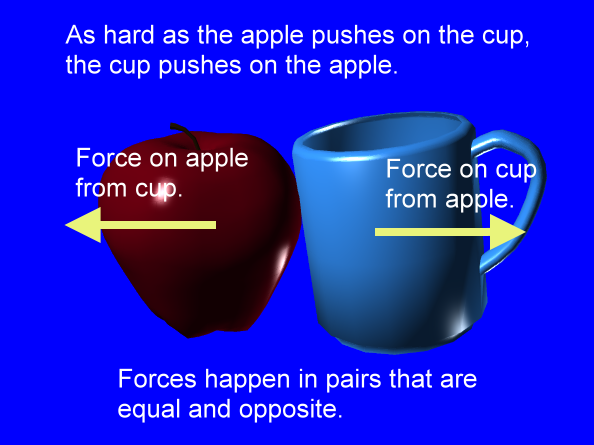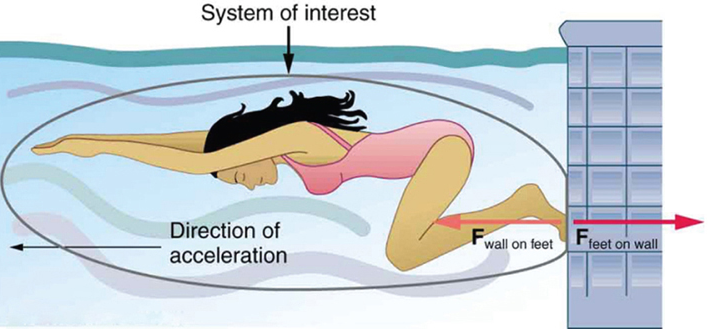What is Newton’s third law of Motion?
The Third Law of Motion states, “If an object A exerts a force on object B, then object B must exert a force of equal magnitude and opposite direction back on object A.”
This law represents a certain symmetry in nature: forces always occur in pairs, and one body cannot exert a force on another without experiencing a force itself. We sometimes refer to this law loosely as action-reaction, where the force exerted is the action and the force experienced as a consequence is the reaction.

So, if an apple and a coffee cup ran into each other, during the collision they would push on each other equally and oppositely:

We can readily see Newton’s third law at work by taking a look at how people move about. Consider a swimmer pushing off from the side of a pool, as illustrated below.

The swimmer pushes against the pool wall with her feet and accelerates in the direction opposite to that of her push. The wall has exerted an equal and opposite force back on the swimmer. You might think that two equal and opposite forces would cancel, but they do not because they act on different systems.
In this case, there are two systems that we could investigate: the swimmer or the wall. If we select the swimmer to be the system of interest, as in the image below, then Fwall on feet is an external force on this system and affects its motion. The swimmer moves in the direction of Fwall on feet. In contrast, the force Fwall on feet acts on the wall and not on our system of interest. Thus Fwall on feet does not directly affect the motion of the system and does not cancel Fwall on feet.
Note that the swimmer pushes in the direction opposite to that in which she wishes to move. The reaction to her push is thus in the desired direction.
What are other examples of Newton’s third law?
- Other examples of Newton’s third law are easy to find. As a professor paces in front of a whiteboard, she exerts a force backward on the floor. The floor exerts a reaction force forward on the professor that causes her to accelerate forward.
- Similarly, a car accelerates because the ground pushes forward on the drive wheels in reaction to the drive wheels pushing backward on the ground. You can see evidence of the wheels pushing backward when tires spin on a gravel road and throw rocks backward.
- In another example, rockets move forward by expelling gas backward at high velocity. This means the rocket exerts a large backward force on the gas in the rocket combustion chamber, and the gas therefore exerts a large reaction force forward on the rocket. This reaction force is called thrust. It is a common misconception that rockets propel themselves by pushing on the ground or on the air behind them. They actually work better in a vacuum, where they can more readily expel the exhaust gases.
- Helicopters similarly create lift by pushing air down, thereby experiencing an upward reaction force.
- Birds and airplanes also fly by exerting force on air in a direction opposite to that of whatever force they need. For example, the wings of a bird force air downward and backward in order to get lift and forward motion.
